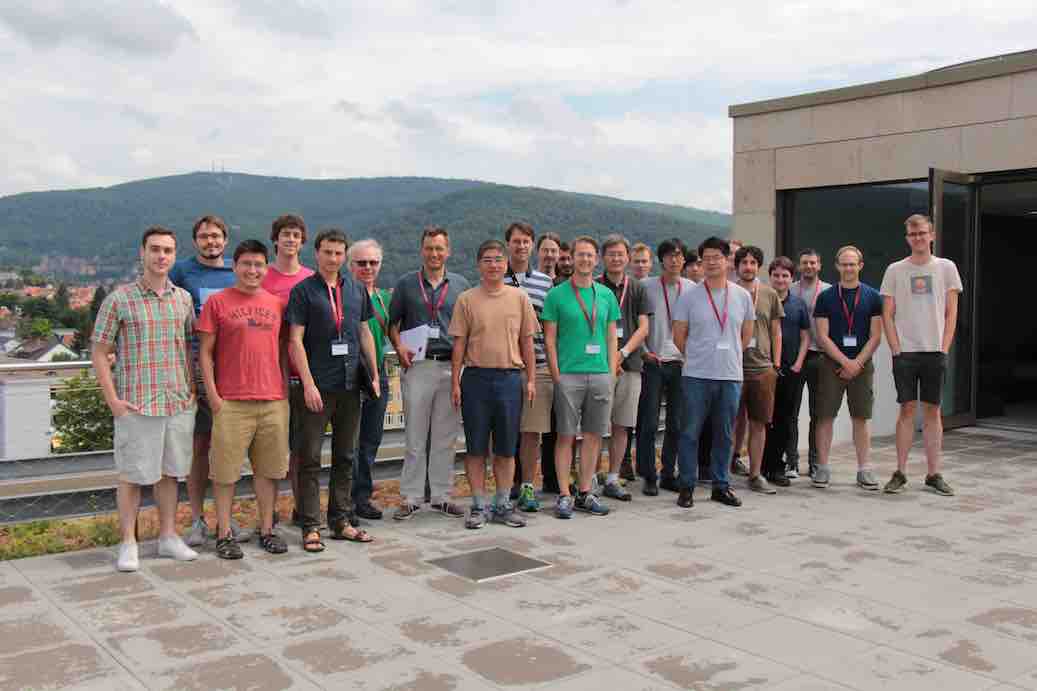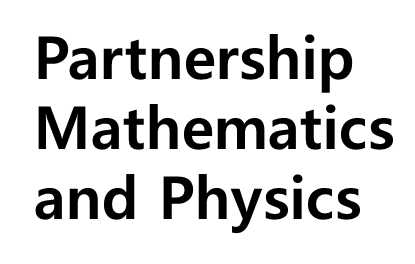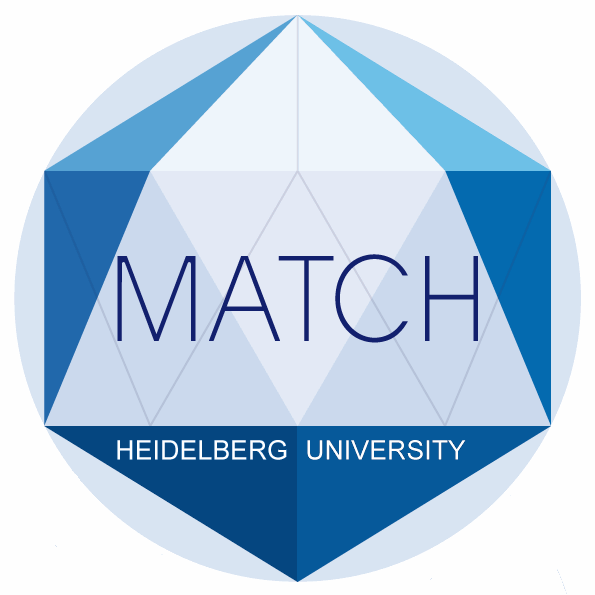Welcome!
From July 20 to 22, 2017, the Mathematical Physics group in the Mathematisches Institut at Universität
Heidelberg will host a three-day workshop on recent topics at the intersection of Physics and Geometry. The
workshop is intended to serve as an unofficial satellite workshop of
String Math 2017, held in Hamburg July 24–29.
Confirmed speakers
-
Matthew Bullimore (Oxford)
-
Mykola Dedushenko (Pasadena)
-
Ori Ganor (Berkeley)
-
Owen Gwilliam (Bonn)
-
Justin Hilburn (Philadelphia)
-
Kentaro Hori (Tokyo)
-
Si Li (Beijing)
-
Hyenho Lho (Zurich)
-
Mauricio Romo (Princeton)
-
Piotr Sułkowski (Warsaw)
-
Brian Williams (Evanston)
-
Piljin Yi (Seoul)
-
Michele del Zotto (Stony Brook)
Participants

Description
Many of the equations that govern the mathematical applications of
quantum field theory and string theory arise as flatness equations, either directly
from the nilpotency of super-variations, or indirectly during a gauge-fixing procedure.
In fact, dressed up with moduli and upon quantization, flat connections have been claimed to
encompass our entire subject. An elementary but rich example are the moduli \( M_{\rm flat} \) of
flat connections over Riemann surfaces, which occur as phase space of Chern-Simons
theory, and whose quantization leads to the computation of dimensions of spaces of sections
of certain bundles over \( M_{\rm flat}\). In the process, the theorem of Narasimhan-Seshadri
identifies \( M_{\rm flat} \) with the moduli space of holomorphic
vector bundles, which in turns allows one to describe them much more explicitly and concretely. When
\( G_{\mathbb C} \) is a complex Lie group and \(G\) its compact real form,
\( M_{\rm flat}(G_{\mathbb C})\) can be identified with the moduli space of \(G\)-Higgs bungles,
connecting \(M_{\rm flat}\) to Hitchin's integrable systems, another flatness landmark.
This workshop views \( M_{\rm flat} \) and related ideas as the backdrop to many recent
developments, a catalyst for progress, and a synecdoche for the many surprising
connections between gauge theory, string theory, geometry and topology.
Our idea is to bring together
researchers in whose work \( M_{\rm flat} \) makes unusual or surprising appearances: people
who have used or developed new or unusual techniques to study \( M_{\rm flat} \), who have
proposed analogues of \( M_{\rm flat}\), or who may not even think of themselves as
studying flat connections at all. We hope that
people with different viewpoints on
these connections will be able to benefit from one another's perspectives this Summer.
The workshop program will highlight recent applications of flat connections in
analyzing BPS spectra, D-brane transport and stability, illustrate the power
of homological algebra and derived algebraic geometry to address real physical
problems, and showcase recent trends emerging from arithmetic questions,
including flux quantization in string theory and various analogies between Galois symmetries in
number theory and global and local symmetries in gauge theory.
We hope the conference will be fairly unique in bringing together mathematicians working on factorization
algebras in QFT and physicists working on categorification, knot homologies, and defects in supersymmetric QFTs.
Program
Thursday, July 20
| Time |
Speaker |
Title, Abstract |
| 9:30am |
Ganor |
Quadratic Reciprocity and Janus Configurations |
|
Compactification of N=4 Super-Yang-Mills theory on a circle with various
SL(2,Z) duality twists will be discussed. A technique for counting
ground states on a torus will be presented, and simple Wilson loops will
be analyzed as well. The partition function on a mapping torus,
calculated in two different ways, leads to the Landsberg-Schaar identity
for quadratic Gauss sums, and generalizations.
|
|
Coffee break
|
| 11:00am |
Sułkowski |
Knots are quivers? |
|
I will present a surprising relation between knot invariants
and quiver representation theory, motivated by various string theory
constructions involving BPS states. Consequences of this relation
include the proof of the famous Labastida-Marino-Ooguri-Vafa
conjecture, explicit (and unknown before) formulas for colored HOMFLY
polynomials for various knots, new viewpoint on knot homologies, new
dualities between quivers, and many others. The crucial role in this
relation is play by A-polynomials -- which represent certain flat
connections in Chern-Simons theory -- and their quantization.
|
| Lunch break |
| 1:30pm |
Bullimore |
The Twisted Hilbert Space of 3d N = 2 Theories
|
|
I will discuss a description of 3d N = 2 gauge theories on R x
C with topological twist on a Riemann surface C as a supersymmetric
quantum mechanics on R. I will focus on a mathematical description of
the Hilbert space of supersymmetric ground states, which in general
contains more information than the twisted partition function on S^1 x
C. In particular, I will consider some simple abelian examples and
demonstrate invariance of the Hilbert space under three-dimensional
mirror symmetry.
|
| 3:00pm |
Yi |
Index, Partition Functions, and Rational Invariants |
|
In recent years, varieties of index-like quantitites
have been computed by exact path integral, a.k.a.
the localization. For gauge theories, the path integral
reduces to contour integrals, albeit with many subtleties.
However, it turns out that interpretation of the result,
which should be really called the twisted partition
function rather than the refined index, requires even
more care.
After a cursory review of the recent derivations and
accompanying subtleties, we consider theories with
noncompact Coulomb phases. The rational nature
of the twisted partition function is observed and
physically explained, which also connects to the
rational invariant of the Kontsevich-Soibelman
wall-crossing algebra. This gives us a nontrivial
tool for extracting the refined and integral index
out of such rational twisted partition functions.
An application to pure Yang-Mills quantum mechanics
solves a decades-old problem of counting D0 bound
states with an Orientifold point. Along the way, we
also resolve a critical conflict between Kac/Smilga
and Staudacher/Pestun, circa 1999~2002, by isolating
the notion of H-saddles. The latter also proves to
be a universal feature of partition functions in the
high "temperature" limit.
|
| 4:15pm |
del Zotto |
Discrete Integrable Systems, Supersymmetric Quantum Mechanics, and
Framed BPS States |
|
It is possible to understand whether a given BPS spectrum is generated
by a relevant deformation of a 4D N=2 SCFT or of an asymptotically free
theory from the periodicity properties of the corresponding quantum
monodromy.
With the aim of giving a better understanding of the above conjecture,
we revisit the description of framed BPS states of four-dimensional
relativistic quantum field theories with eight conserved supercharges in
terms of supersymmetric quantum mechanics.
We unveil aspects of the deep interrelationship in between the
Seiberg-dualities of the latter, the discrete symmetries of the theory
in the bulk, and quantum discrete integrable systems.
|
Friday, July 21
| Time |
Speaker |
Title, Abstract |
| 9:30am |
Williams |
Symmetries of higher dimensional holomorphic field theories |
|
The most well known examples of holomorphic field theories come from chiral CFTs in complex dimension one. Of the symmetries of these theories, a special role is played by both the Kac-Moody and Virasoro vertex algebras. In this talk I will discuss generalizations of these symmetries to higher dimensions in the language of factorization algebras. For example, holomorphic gauge theories in complex dimension d (theories depending on the data of a holomorphic connection) generically have the symmetry of a certain dg Lie algebra studied recently by Faonte, Hennion, and Kapranov. My talk will focus on this higher Kac-Moody algebra and I will relate it to a shadow of a richer OPE algebra. Time permitting, I will discuss a similar picture for the higher Virasoro algebras.
|
|
Coffee break
|
| 11:00am |
Gwilliam |
Chern-Simons theory and Koszul duality |
|
The observables of perturbative Chern-Simons theory naturally form an algebra over the
little 3-disks operad, as I will explain. In consequence, line operators form a braided
monoidal category. We then use higher abstract nonsense, notably Koszul duality, to recover
a quantum group with formal parameter. This work in progress is joint with K. Costello and
J. Francis.
|
| Lunch break |
| 1:30pm |
Lho |
Stable quotient and holomorphic anomaly equations |
|
I will prove holomorphic anomaly equations for the stable quotient invariant of
Local P^2 in precise form predicted by B-model Physics. After that I will also
discuss about the holomorphic anomaly equation for [C3/Z3] and formal quintic invariants.
This talk is based on joint work with Rahul Pandharipande.
|
| 3:00pm |
Li |
Quantum master equation and integrable hierarchy |
|
We establish the Batalin-Vilkovisky quantization theory for chiral deformation of free
conformal field theories. As an application, we describe a universal approach to intebrable
hierarchies associated to topological B-model on Calabi-Yau geometry. The talk is based on
arXiv: 1612.01292[math.QA] and a joint work in progress with Weiqiang He and Philsang Yoo.
|
| 4:15pm |
Hilburn |
S-duality of boundary conditions
for 4d N=4 and ring objects in the geometric Satake category |
|
In a recent paper Braverman, Finkelberg, and Nakajima showed how one can associate
a ring object in the category of equivariant D-modules on the affine Grassmannian
Gr_G to a 3d N=4 gauge theory whose cohomology gives the ring of functions on the
Coulomb branch. I will explain a physical context for this result in terms of boundary
conditions to 4d N=4 super Yang-Mills and use this to give a mathematical formulation
of some ideas of Gaiotto.
|
Saturday, July 22
| Time |
Speaker |
Title, Abstract |
| 9:30am |
Hori |
2d Seiberg duality, with boundary |
|
I will talk about 2d Seiberg duality and discuss how it may
act on the B-type boundary conditions. The grade restriction
rule, obtained from the hemisphere partition function, plays
an important role. Based on a joint work in progress with Richard Eager.
|
|
Coffee break
|
| 11:00am |
Dedushenko |
Four-manifold invariants and 2d CFT |
|
Recently, it has been conjectured that there exists a class of 2d N=(0,2) SCFTs T[M_4, G],
labeled by a 4-manifold M_4 and a Lie group G, which could provide a new type of smooth structure
invariants for M_4. Such theories are given by twisted compactifications of the 6d (2,0) theory on M_4.
We study one of the simplest cases when G=U(1). Even though such T[M_4, U(1)] looks trivial
(in particular, it is free), from the string theory point of view, it is natural to include
certain local defect operators in this theory. They are naturally defined in the UV, while in
the IR description they explicitly depend on the Seiberg-Witten (SW) invariants of
M_4. T[M_4, U(1)] perspective leads to the equivariant multi-monopole generalization of
SW invariants. We study them from several points of view, including the 4d gauge theoretic
approach, and identify the structure of the VOA T[M_4, U(1)]. We also propose some further
directions for generalizations, including the case of non-abelian G.
|
| Lunch break |
| 1:30pm |
Romo |
All-Order Volume Conjecture for
Closed 3-Manifolds from Complex Chern-Simons Theory |
|
I will review some general aspects of complex Chern-Simons theory on hyperbolic
3-manifolds, focusing on the case of gauge group G=SL(2,C). After a brief introduction
to the Volume Conjecture (VC), for knot complements and, a very recent mathematical proposal,
for closed hyperbolic 3-manifolds, I'll show how complex Chern-Simons theory is related with
them and how this connection leads to a novel generalization of the most recently proposed
VC for closed 3-manifolds.
|
Practical Information
Venue
All talks will be held in the 5th floor Conference Room (5/104) in the Southern wing
of the
MATHEMATIKON.
Morning and afternoon coffee/tea and lunches will be served in the 5th floor common room.
Accommodation and Provisioning
The Heidelberger Hof
hotel is conveniently located midway
between the Neuenheimer Feld and the main attractions of old town Heidelberg.
For a fast bus connection to Campus, board route 31 at Bismarckplatz, headed
to Kopfklinik
(not Universitätsplatz!) and get off 5 stops later at Bunsengymnasium. The main
entrance of the
MATHEMATIKON is across the street.
Shops and restaurants are in the middle and Northern wing.
The pleasant walk from Bismarckplatz across the bridge, down the Neckar river, and up Berliner
Strasse takes about 25 minutes.
Registration and Workshop Dinner
There is no registration fee, however we ask that all those interested in attending
the talks send us an
Email ahead of time, so we may have an idea of the number of prospective participants.
(We reserve the right to raise a guard in the unlikely event of a general stampede.)
In your message, please indicate whether or not you are interested in joining us for the
workshop dinner on Friday night. You will be asked for a € 20 contribution for the dinner;
further information to follow.
Organizers
For any further information, please send us an
Email
Sponsors



